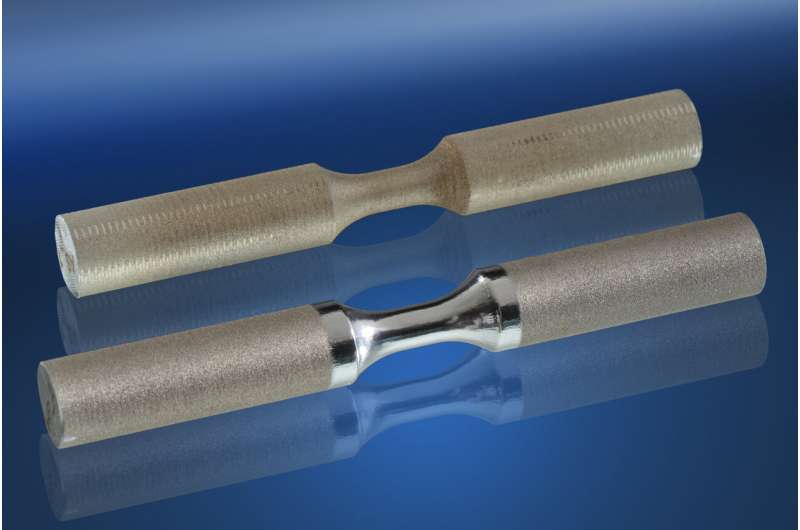Laser polishes 3D-printed metal parts better than ever before
Researchers from Skoltech and MEPhI have devised a laser polishing technique that effectively removes both surface roughness and subsurface pores in intricately shaped metal parts manufactured with a 3D printer. Described in Optics & Laser Technology, the new method is particularly well-suited for the surface treatment of medical implants. The paper demonstrates that it outperforms previously available techniques, which tend to work well when either roughness or porosity is the issue, but not both.
“3D printers can produce metal parts of very intricate shapes, but the surface ends up being rough and there are unwelcome pores about a tenth of a millimeter below the surface,” the first author of the study, Skoltech Materials Center Ph.D. student Daniil Panov commented. “Our group has tweaked the conventional laser polishing process in a way that it now reduces both surface roughness and subsurface porosity by a factor of about 10 on steel; and there is no reason why it should not work with titanium or cobalt-chromium—the other common materials for medical implants.”
This is remarkable, because no other finishing technique can solve both of these problems at once in a satisfactory manner. Conventional laser polishing, for example, is good for dealing with surface roughness, but it does not really help with unwanted pores, because it does not melt the metal deep enough to reach the pores buried about 0.1 mm below the surface. Other, impact-based techniques use particles or laser pulses to repeatedly “hammer” the surface, resulting in pore removal, but these achieve moderate results when it comes to reducing surface roughness—in fact, some of them even increase it.
“The idea behind the method is simple: Rather than complete several passes over the surface with a laser at ‘optimal’ power, as it happens in conventional laser polishing, we step up the power during one of the passes, melting a thicker layer of metal,” Panov explains. “The optimal power is called that for a reason, so this tweak does sacrifice some surface quality in terms of roughness. But this minor tradeoff of several percent is truly insignificant when you consider the payoff of getting rid of the pesky subsurface defects.”

The only alternative would be machine treatment, which mechanically removes the top 0.2 mm of the material, doing away with the pores and leaving behind a smooth surface. However, this effectively defeats the purpose of 3D printing, because if the shape is simple enough to be machined, then a 3D printer probably wouldn’t have been used in the first place.
“We also investigated how our finishing technique affects metal fatigue,” Panov added. “Along with surface roughness and subsurface porosity, this property is also important for medical implants, because they are exposed to repeated mechanical stress. It turned out that not only do you get an approximately 90% reduction in roughness and porosity, but the resulting material also gains in fatigue properties.”
While in this study the researchers worked with steel, they say their technique can be transferred to 3D-printed parts made of the other two metals commonly used in medical implants: titanium and the cobalt-chromium alloy. This is what the team is currently working on.
“Subsurface pores are the weak spots from which material deterioration begins following exposure to cyclic loads, so it is critical that they be removed,” Panov said. “Also, if you look at an artificial knee joint, for example, you will notice that it has a complex shape and some of its surfaces are exposed to repeated friction—and therefore need to be extremely polished—but for others, some roughness could be beneficial in terms of integration with biological tissue. Laser polishing has the precision to achieve that kind of selectivity.”
The principal investigator of the study, Associate Professor Igor Shishkovsky of Skoltech’s Center for Materials Technologies, commented, “What also makes our technique interesting is that you can use it to create structured surfaces with artificial micropatterns. This may range from the better-known effects such as enhancing the surface’s oil-absorption properties, wetting conditions, and trivial engraving to more challenging tasks: implant surface structuring prior to surgery, identification tag placement, and forming diffraction grids on the surface for functional device diagnostics, among other things.”
Daniil Panov et al, Pore healing effect of laser polishing and its influence on fatigue properties of 316L stainless steel parts fabricated by laser powder bed fusion, Optics & Laser Technology (2022). DOI: 10.1016/j.optlastec.2022.108535
Citation:
Laser polishes 3D-printed metal parts better than ever before (2022, September 7)
retrieved 7 September 2022
from https://techxplore.com/news/2022-09-laser-3d-printed-metal.html
This document is subject to copyright. Apart from any fair dealing for the purpose of private study or research, no
part may be reproduced without the written permission. The content is provided for information purposes only.
For all the latest Technology News Click Here
For the latest news and updates, follow us on Google News.
